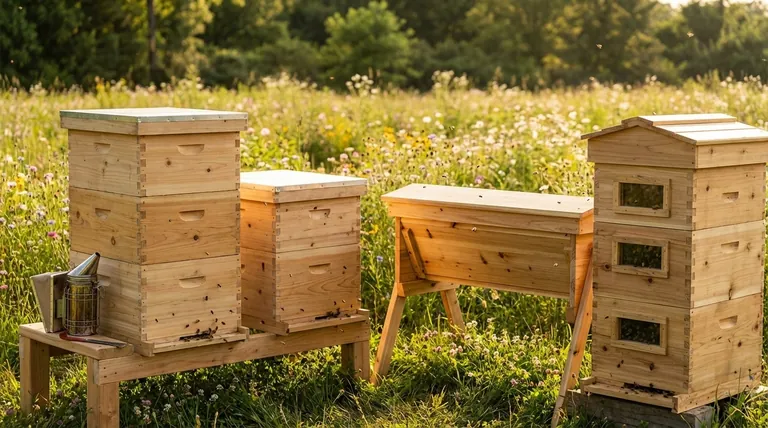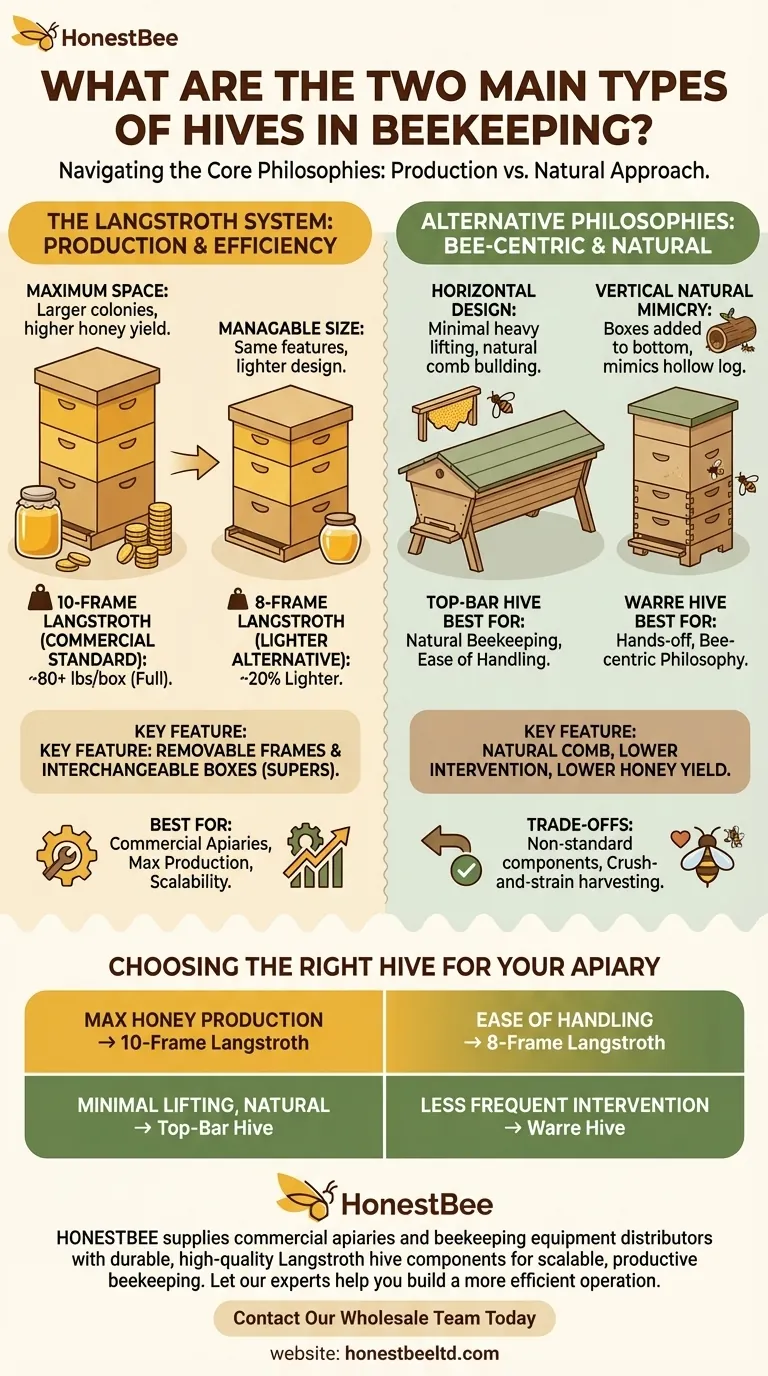In modern beekeeping, the two most common hive configurations are the 8-frame and 10-frame Langstroth hives. These numbers refer to the quantity of removable frames that fit side-by-side within a single hive box. While this is the most frequent distinction, it represents a choice within one specific hive system, not the only two types of hives that exist.
The core decision a beekeeper must make is not simply between an 8-frame or 10-frame hive, but about the fundamental beekeeping philosophy they wish to follow—choosing between a system designed for maximum production versus one designed for a more natural, bee-centric approach.

Deconstructing the "Standard" Hive: The Langstroth System
The Langstroth hive, patented in 1852, is the most dominant hive design in North America and many other parts of the world. Its revolutionary design features vertically stacked boxes (called "supers") and removable frames, which allow beekeepers to inspect the colony and harvest honey without destroying the comb.
The 10-Frame Hive: The Commercial Standard
The original and most widespread Langstroth configuration holds ten frames per box. This size is the default for most commercial apiaries and beekeeping suppliers.
Its primary advantage is space. A 10-frame box offers more room for the queen to lay eggs and for bees to store honey and pollen, potentially leading to larger colonies and greater honey yields per box.
The 8-Frame Hive: The Lighter Alternative
An 8-frame hive is simply a narrower version of the 10-frame standard, using the same frame sizes but fitting only eight into each box.
Its key benefit is weight. A full 10-frame deep box of honey can weigh over 80 pounds (36 kg), whereas an 8-frame deep box is about 20% lighter, making it a more manageable option for many hobbyist beekeepers.
Why the Number of Frames Matters
The choice between 8 and 10 frames directly impacts hive management. It influences the total weight you'll be lifting, the amount of space available for the colony's growth, and the interchangeability of your equipment with other beekeepers.
Exploring Alternative Hive Philosophies
Beyond the Langstroth system, other hive types exist that reflect a different approach to beekeeping, often prioritizing natural bee behavior over ease of honey harvesting.
The Top-Bar Hive
This is a single, long, horizontal hive. Instead of full frames, bees build their comb down from simple wooden bars ("top bars") placed across the top of the hive cavity.
Management is less intrusive, as the beekeeper typically inspects only one comb at a time. This design is popular in the natural beekeeping community and eliminates the need for heavy lifting of stacked boxes.
The Warre Hive
Often called the "vertical top-bar hive," the Warre hive is designed to more closely mimic the hollow log a bee colony would inhabit in nature.
The key principle is adding new boxes to the bottom of the stack, not the top. This allows the colony to expand downwards naturally, keeping the brood nest warm at the top while honey is stored below.
Understanding the Trade-offs
Choosing a hive type involves balancing honey production goals, management style, and physical limitations. There is no single "best" hive, only the best hive for your specific goals.
Langstroth: High Production, High Intervention
The Langstroth system is designed for efficiency and scalability. Its interchangeable parts and foundation-based frames maximize honey production and allow for detailed inspections.
The primary trade-offs are the heavy weight of the boxes and a management style that can be more disruptive to the colony's natural processes.
Top-Bar & Warre: Natural Comb, Lower Yield
These hives are designed to be more bee-centric. They allow bees to build their own natural-sized comb and generally require less frequent, less intrusive inspections.
The trade-offs include typically lower honey yields, non-standardized components, and a honey harvesting process that involves crushing the comb rather than spinning it in an extractor.
Making the Right Choice for Your Apiary
Your hive choice should be a deliberate decision based on your personal beekeeping philosophy and physical capabilities.
- If your primary focus is maximizing honey production: The 10-frame Langstroth is the proven industry standard for achieving the highest yields.
- If your primary focus is ease of handling and physical accessibility: The 8-frame Langstroth offers the benefits of a standard system in a lighter, more manageable package.
- If your primary focus is natural beekeeping with minimal heavy lifting: The horizontal Top-Bar hive is an excellent choice that is easy on your back.
- If your primary focus is mimicking a natural bee colony with less frequent intervention: The Warre hive provides a vertical, bee-friendly environment that requires a more hands-off approach.
Ultimately, the best hive is the one that aligns with your goals and keeps you engaged and successful in your beekeeping journey.
Summary Table:
| Hive Type | Key Features | Best For |
|---|---|---|
| 10-Frame Langstroth | Maximum space, high honey yield, industry standard | Commercial apiaries, maximum production |
| 8-Frame Langstroth | Lighter weight, standard system benefits | Hobbyists, beekeepers with physical limitations |
| Top-Bar Hive | Horizontal design, natural comb, minimal heavy lifting | Natural beekeeping, ease of handling |
| Warre Hive | Vertical design, bottom-box addition, mimics natural habitat | Hands-off, bee-centric philosophy |
Ready to choose the right hive system for your apiary? HONESTBEE supplies commercial apiaries and beekeeping equipment distributors with the durable, high-quality Langstroth hive components and equipment needed for scalable, productive beekeeping. Let our experts help you build a more efficient operation. Contact our wholesale team today to discuss your needs!
Visual Guide

Related Products
- Langstroth Bee Hives Bee Keeping Box for Beginners Beekeeping
- Long Langstroth Style Horizontal Top Bar Hive for Wholesale
- Ergonomic Two Person Foldable Hive Lifter
- Multi-Functional Sliding Hive Entrance for Beekeeping
- HONESTBEE Advanced Ergonomic Stainless Steel Hive Tool for Beekeeping
People Also Ask
- How does the orientation of the hive sides benefit comb construction? Ensure Straight, Movable Combs for Easier Hive Management
- What are the key features of the Langstroth beehive? A Guide to the Standard for Modern Beekeeping
- How does the ease of access differ between 8-frame and 10-frame hives? Choose the Right Hive for Your Body
- What is the best type of bee hive for beginners? Start with the Proven Langstroth Standard
- Why are Langstroth hives recommended for beginners? Unmatched Support & Standardization



















